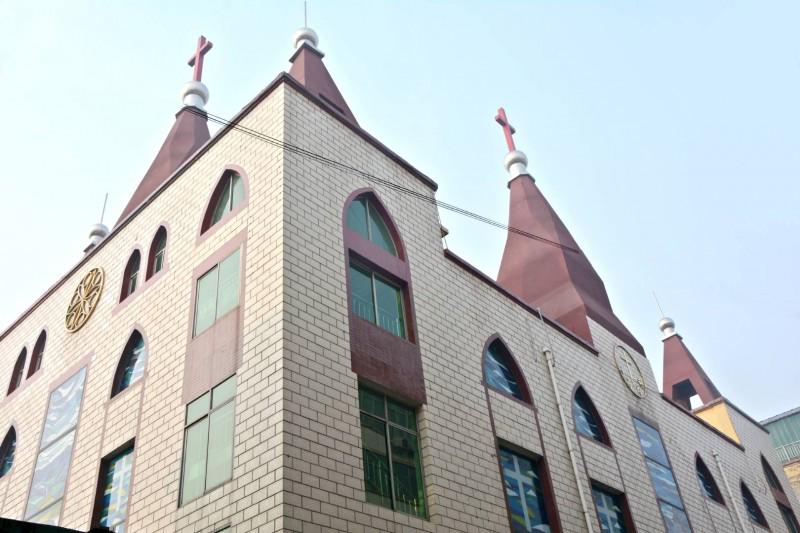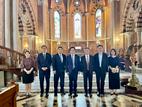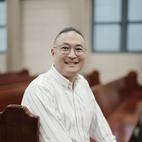Christianity was preached in the latter stage of the Qing Dynasty in Linfen (formerly called Pingyang).
The hard beginning
In 1877, two ministers including Joshua John Turner from the British China Inland Mission organization (CIM) started preaching in Linfen under the identity of disaster inspectors. The following year, Joshua John Turner and David Hill settled down in Linfen and began a preaching ministry as relief aiders.
In 1879, Hill bought a court yard for the church and for accommodation. The following year, he bought another courtyard for the church and for a primary school. In the same year, a local scholar named XI Zizhi was able to study the Christian cathecism from an ad for articles posted by the then-Shanxi preachers, Timothy Richard and David Hill. Xi, then familiarized himself with the Bible while he worked as a Chinese teacher for David Hill. Consequently, Xi was converted to Christianity and changed his name to XI Shengmo (literally "devil slayer"), being determined to quit opium addiction, and opened opium treatment centres for promoting the abandonment of opium addiction and preaching of the Gospel.
In 1886, the general director of CIM, Hudson Taylor, ordained Xi Shengmo in a service attended by more than 300 people in Hongdong County, commissioning him to be in charge of the ministry for the south Shanxi region. Two elders were ordained and 16 deacons were assigned to assist the work.
In 1893, Dr. William Millar Wilson and his wife, both with CIM, came to Linfen in the name of the church to buy two courtyards out of their own pocket for establishing Linfen Church Hospital to treat male patients.
By 1900 Christianity had been introduced in various locations and the number of believers had reached into the hundreds. A villager opened an opium treatment centre in his own house, helping others to abandon opium and hear the Gospel.
That same year, the anti-imperialism movement of the Boxer Rebellion started. The Boxers saw all British missionaries as the invasion of British imperialism, and Christianity as the religion from "across the sea" and to be refused. They burned the church's properties and killed believers. The church and its hospital were destroyed in a fire. The Wilsons, including their children, were beheaded on 9th July that same year by Shanxi Inspector YU Xian before the screen wall of the town hall. Other missionaries and 61 Chinese believers were also martyred.
In 1901, after the signing of the Boxer Protocol, Reverend Henry Lyons came to Linfen to check out the church's plans. The head of the Linfen Boxers, DONG Futian, was arrested and executed by the Qing Government. The church was compensated for damages. A relative of Dr. Wilson, who was killed in the movement, used the compensation money to build a church hospital in Linfen.
In 1912, a British doctor Sydney H. Carr was put in charge of rebuilding Linfen Church Hospital in memory of Dr. Wilson, and named it Wilson Memorial Hospital, treating male patients only. The original church hospital treated only female patients.
Two or three years after the Boxer Rebellion, the church began recovering from the destruction. Linfen churches were allowed to expand continuously and four new churches were established. Xiyi Church bought about 0.13 hectare of land for construction and gradually became the main church for local Christianity activities.
The increase
When beginning the 1920s and 1930s, Sunday worship had been the norm. Believers preached the Gospel in the streets and amongst houses. WANG Dasan, who attended Huiying Primary School of Linfen Church, recalled that it was a time of revival in the Linfen churches. During each Sunday service, Holy Communion was served to a large gathering, with the street on which He Er Hutong Church was located encountering heavy traffic jams.
Moreover, Linfen Church established a Bible Reading House (original English name unknown). Every March and July, the church would organise large gatherings where men and women lived separately but ate and worshipped together. There were sermons preached every day with over 500 attending. There were also new believers baptized at each annual conference.
Furthermore, around 1920, Linfen church bought a piece of land near the north-west corner of the male hospital to build a hospital for women. The new hospital had a three-year medical degree programme and had ran the progam five times, educating new staff in medical expertise and pharmacy for the Linfen region.
By 1921, Linfen Church had expanded to a capacity of about one thousand with chapels, meeting rooms, accommodation and offices built and the 11 primary school buildings on the south side merged into the church.
In 1925, the Gospel Chapel, designed by Reverend QIAO Zhiji, was built with a preaching room, a youth room, a library and a room for playing ping pong. Under the directorship of Reverend LAI Yian, two new courtyards were added so that there were three as a seminary and accommodation.
As the church expanded, Reverend Qiao Zhiji and Reverend LI Rang suggested the church become autonomous. So by 1931, they established the Chinese Christian Mission of North China. However, due to their differing views as well as a tight budget, Qiao and Li set about on their own course and left the organisation to the unknown.
The difficulty
In the earlier stage of the anti-Japanese war, a Sunday service would have 400 - 500 believers attending. During the Christmas season, there would be a thousand. Meanwhile, the male and female hospitals had 200 and 100 beds respectively. At that time, Wilson Memorial Hospital had treated up to 10,000 wounded front-line soldiers.
In February 1938, after the Japanese forces occupied Linfen, Reveren PAN Yanggui returned to Linfen from Tianjin and established a refugee camp at Linfen Church receiving nearly a thousand refugees. They maintained their livelihood by doing laundry. The main hall of the Church was used as a cinema by the Japanese. Believers had to hide and secretly hold services. The church and the hospital were both occupied by Japanese forces.
In September 1945, after the victory over the Japanese, apart from the female hospital being used as military warehouse and iron factory under the YAN Xishan administration, all other property was given back to the Church. The UN Relief and Rehabilitation Administration was located at the Church. Within the Admin there was a clinic for free treatment. One year later, the Admin was recalled and the clinic stopped running.
From the time of the victory over the Japanese until 1949, the number of participants at each of the Church's worship services declined to its regular number of about 200 - 300.
After 1949, the internal conflicts within the Church started to intensify. In 1952, the local Religious Affairs Bureau helped the Church to establish an inspection committee. For the church management, Shanxi Provincial Three-self committee chair YANG Mingbao came to help Linfen Church. He and the local authorities established a board of directors for the Church. However, no one was in charge of pastoral ministry. By the autumn of 1952, Reverend Qiao Zhiji returned to Linfen to host pastoral ministry until 1966 when he passed away.
The Great Cultural Revolution started in the autumn of 1966 and since then all ministries of Linfen Church have been greatly impacted. All worship activities were held in smaller chapels with 50 - 60 attending. The Bibles and files belonging to the Church were burnt. Eventually, the Church was closed down and all religious events ceased.
Rebirth
In 1979, as the rumor was the churches could hold open services again, a sister named CHENG Shuen first started worshipping in a believer's house. The service began with two or three attending and gradually increased to over 20 or 30 people.
In 1980, China's religious freedom policy was gradually restored and Linfen Church's services were also officially restored.
By 1982, over half of the small chapels were returned to the Church. In the following year, the first Linfen Municipal Christian Three-self Patriotic Committee was elected. In March 1987, all properties lost during the Cultural Revolution were returned to the Church.
After that, the number of believers constantly increased. By 1989, with an attendance of 400 to 500, services had to be divided into morning and afternoon to meet the increasing demand.
In 1996, the former Linfen authority granted Christian services to be public and 21 locations were registered, five for temporary locations and five locations deferred. By the end of 1998, there were over 50,000 believers in churches belonging to the Three-self Patriotic Movement (TSPM). Apart from this, there were various private locations and many unregistered independent ministers who did not belong to the Three-self. Traditional house churches were located everywhere in the region and it was hard to know the exact number of attendees.
In the new millennium, around the year 2000, a cult named Eastern Lightning appeared in the region. They misinterpreted the Bible and had some influence in some parts.
By 2002, Linfen Church was refurbished, having a brand new five-storey church building with an area of over 2,700 square metres. In addition, a basement was constructed.
The main hall for worship services was extended from the original capacity of 400 to a second and third hall of a capacity of 1,000. Four ordained pastors, 15 elders and over 200 deacons were ordained by 180 officially registered pastors.
- Translated by Charlie Li












